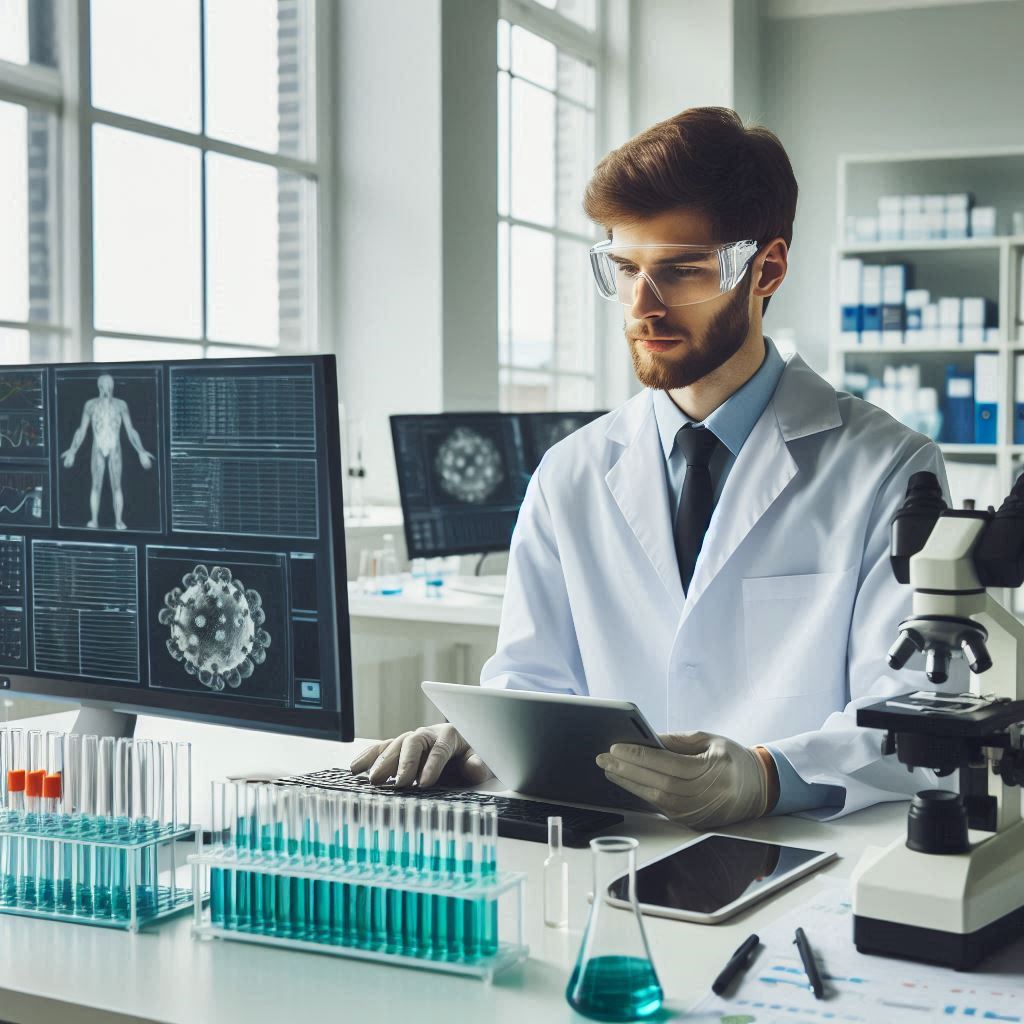Introduction
Biostatistics applies statistical methods to analyze biological and health data.
It plays a crucial role in advancing healthcare and medical research.
Biostatisticians design studies, interpret results, and ensure health decisions rely on sound evidence.
The growing importance of data in healthcare has significantly increased the demand for biostatisticians.
Their work influences various fields, including epidemiology, genetics, and clinical trials.
Biostatisticians help identify disease trends, measure treatment outcomes, and assess public health interventions.
As healthcare data expands, biostatisticians offer valuable insights for making informed decisions.
They work in diverse settings, from research institutions to government agencies and pharmaceutical companies.
Their expertise ensures that medical practices and policies are based on reliable data analysis.
The demand for biostatistics professionals continues to rise due to advancements in technology and data-driven healthcare.
Careers in biostatistics offer rewarding opportunities with a wide range of applications in public health, research, and industry.
Biostatisticians play a vital role in solving complex biological problems and improving patient care.
As the field evolves, biostatistics remains essential for addressing health challenges and driving scientific progress.
Overview of Biostatistics
Definition of Biostatistics and Its Importance in Various Industries
Biostatistics is a branch of statistics focused on analyzing and interpreting data related to living organisms.
This field combines statistical techniques with biological knowledge to inform decision-making in various industries.
Biostatisticians play a vital role in healthcare, public health, and research.
In healthcare, biostatistics helps assess the effectiveness of treatments and interventions.
Biostatisticians design clinical trials to evaluate new drugs and therapies.
They analyze data from these trials to determine if treatments are safe and effective.
Their work ensures that healthcare providers have reliable information to guide patient care.
Public health relies heavily on biostatistics to monitor health trends and inform policy decisions.
Biostatisticians analyze data on disease outbreaks, vaccination rates, and health behaviors.
This analysis helps identify at-risk populations and develop strategies to improve public health outcomes.
By interpreting data on health issues, biostatisticians contribute to designing effective public health programs.
How Biostatisticians Analyze and Interpret Data in Healthcare, Public Health, and Research
In research, biostatistics provides the foundation for rigorous scientific studies.
Biostatisticians collaborate with researchers to design experiments and analyze data.
They apply statistical methods to ensure that research findings are valid and reliable.
This collaboration enhances the credibility of research outcomes and drives advancements in science.
Biostatistics is crucial for understanding complex biological systems.
Biostatisticians use statistical models to make sense of large datasets.
They identify patterns and trends that inform scientific discoveries and advancements.
By interpreting data accurately, they contribute to the body of knowledge in various fields.
The importance of biostatistics extends beyond traditional healthcare and research.
Industries such as pharmaceuticals, environmental science, and agriculture also rely on biostatistical methods.
Biostatisticians work in these sectors to analyze data related to product safety and efficacy.
Their skills help ensure that products meet safety regulations and improve public health.
As the demand for data-driven decision-making increases, biostatistics becomes increasingly important.
The rise of big data in healthcare and research creates a need for skilled biostatisticians.
These professionals can analyze complex datasets and extract meaningful insights.
Their expertise is essential for guiding policy decisions and improving patient outcomes.
Furthermore, biostatistics offers diverse career opportunities.
Graduates can work in academia, government agencies, and private industries.
Many biostatisticians find fulfilling careers in pharmaceutical companies or research institutions.
The demand for biostatisticians continues to grow, providing job stability and career advancement.
Biostatistics is a critical field that combines statistical analysis with biological knowledge.
Biostatisticians analyze and interpret data to inform decisions in healthcare, public health, and research.
Their work has a lasting impact on improving health outcomes and advancing scientific knowledge.
Choosing a career in biostatistics opens doors to diverse opportunities and contributes to meaningful change in society.
Read: Profiles in Success: Leading Chemists of the 21st Century in the US
Job Opportunities in Biostatistics
Biostatistics offers a wide range of career options for professionals passionate about data and health.
Various roles, such as biostatistician, data analyst, and research scientist, exist in this field.
Each position contributes uniquely to healthcare, public health, and research.
Career Options in Biostatistics
A biostatistician plays a vital role in analyzing data related to biological and health sciences.
They design experiments, analyze clinical trial data, and interpret findings.
Their work helps determine the safety and efficacy of new drugs and treatments.
Biostatisticians often collaborate with healthcare professionals and researchers to ensure accurate data analysis.
Data analysts in biostatistics focus on interpreting complex datasets to derive meaningful insights.
They work with large volumes of data, using statistical software to identify trends and patterns.
Data analysts may also develop data visualization tools to communicate findings effectively.
Their skills are valuable in various sectors, including healthcare, finance, and technology.
Research scientists specializing in biostatistics design and conduct studies to advance scientific knowledge.
They formulate research questions, develop hypotheses, and analyze data.
Research scientists may work in academic institutions, government agencies, or private research firms.
Their contributions drive innovation in health and medicine.
High Demand for Biostatisticians
The demand for biostatisticians is rapidly growing in both public and private sectors.
Healthcare organizations increasingly rely on data-driven decision-making.
They need skilled professionals to analyze data related to patient outcomes, treatment efficacy, and disease trends.
As a result, biostatisticians play a crucial role in improving patient care and public health initiatives.
Pharmaceutical companies also seek biostatisticians to support drug development and regulatory compliance.
These professionals analyze clinical trial data, ensuring that new treatments meet safety standards.
Their expertise is essential for navigating complex regulatory environments.
Government agencies hire biostatisticians to monitor public health trends and inform policy decisions.
These professionals analyze data related to disease outbreaks, vaccination rates, and health behaviors.
Their insights help identify at-risk populations and develop targeted interventions.
In addition to traditional sectors, biostatistics offers opportunities in emerging fields.
The rise of big data in healthcare creates a need for skilled data scientists and analysts.
These professionals use advanced statistical techniques to analyze vast datasets, leading to innovative solutions.
Biostatisticians also find opportunities in academia, where they can teach and mentor future generations.
They contribute to the advancement of knowledge through research and publication.
This combination of teaching and research offers a fulfilling career path for those passionate about biostatistics.
Biostatistics provides diverse career options, including biostatistician, data analyst, and research scientist.
The high demand for skilled biostatisticians spans public and private sectors.
With increasing reliance on data-driven decision-making, biostatistics offers a promising and rewarding career path.
Pursuing a career in biostatistics opens doors to impactful opportunities in health and research.
Read: The Life and Times of a U.S. Physicist: A Day in Detail
Competitive Salaries
Biostatistics offers competitive salaries, making it an attractive career choice for data professionals.
As the demand for skilled biostatisticians increases, organizations are willing to invest in top talent.
Professionals in this field often earn higher salaries compared to many other scientific disciplines.
Salaries for Biostatisticians
According to various industry reports, entry-level biostatisticians earn an average salary of $70,000 annually.
As professionals gain experience and expertise, their earning potential increases significantly.
Mid-level biostatisticians can expect salaries ranging from $80,000 to $100,000.
Senior biostatisticians and managers often earn over $120,000, reflecting their advanced skills and leadership responsibilities.
Biostatisticians working in the pharmaceutical industry tend to earn higher salaries than those in other sectors.
In this field, professionals can earn upwards of $150,000, particularly if they are involved in high-stakes clinical trials.
Additionally, biostatisticians employed by government agencies often enjoy stable salaries with excellent benefits.
Impact of Experience on Salaries
Experience plays a crucial role in determining salaries within biostatistics.
Entry-level positions typically offer lower salaries, as professionals are still building their skills.
However, with experience comes increased responsibility and expertise, leading to salary growth.
Mid-career professionals with five to ten years of experience can command higher salaries.
At this level, biostatisticians often lead projects and mentor junior staff.
Their ability to analyze complex datasets and draw meaningful conclusions becomes invaluable.
This experience boosts their marketability, allowing them to negotiate better compensation packages.
Specialization and Earning Potential
Specialization within biostatistics can significantly impact earning potential.
Professionals focusing on niche areas, such as clinical trials, epidemiology, or bioinformatics, often earn higher salaries.
Specialized skills are in high demand, as organizations seek experts to address specific challenges.
For instance, biostatisticians with expertise in machine learning or big data analytics can command premium salaries.
These professionals possess advanced technical skills that are increasingly valuable in a data-driven world.
Their ability to leverage cutting-edge techniques can set them apart from their peers.
Additionally, biostatisticians who pursue further education, such as a master’s degree or Ph.D., can enhance their earning potential.
Advanced degrees provide deeper knowledge and specialization, allowing professionals to take on more complex roles.
Organizations often offer higher salaries to individuals with advanced qualifications, reflecting their expertise.
Biostatistics offers competitive salaries that increase with experience and specialization.
Entry-level biostatisticians earn approximately $70,000 annually, while mid-career professionals can earn between $80,000 and $100,000.
Specialization in high-demand areas significantly boosts earning potential, particularly in the pharmaceutical industry.
Professionals with advanced degrees can further enhance their salaries and career prospects.
Biostatistics not only provides a rewarding career but also a financially promising future.
Read: Salary Ranges: What to Expect as a Physicist in the USA

Impact on Public Health
Biostatisticians play a crucial role in improving public health outcomes.
They analyze data to identify trends, risks, and effective interventions.
Their work directly influences healthcare policies, contributing to better health for communities.
Role of Biostatisticians in Public Health
Biostatisticians collect and analyze data from various sources, including surveys and clinical trials.
They interpret this data to provide insights into health trends.
Their expertise helps identify health issues affecting populations, such as chronic diseases and infectious outbreaks.
Through statistical methods, biostatisticians evaluate the effectiveness of public health interventions.
They assess the impact of vaccination programs, screening initiatives, and health education campaigns.
By analyzing outcomes, they provide evidence-based recommendations for future strategies.
Biostatisticians also collaborate with epidemiologists to understand disease patterns.
They use statistical models to predict the spread of diseases and identify at-risk populations.
This collaboration leads to targeted interventions that improve health outcomes.
Influencing Healthcare Policies
Biostatistics has significantly influenced healthcare policies and interventions.
For example, during the COVID-19 pandemic, biostatisticians played a vital role in data analysis.
They tracked infection rates, hospitalizations, and vaccination coverage to guide public health responses.
Their analyses informed decisions on lockdown measures, mask mandates, and resource allocation.
This data-driven approach helped mitigate the impact of the virus and protect public health.
In another instance, biostatisticians contributed to the development of smoking cessation programs.
They analyzed the effectiveness of various interventions, such as counseling and nicotine replacement therapy.
Their findings guided policymakers in implementing effective smoking bans and educational campaigns.
Case Study: Vaccine Development
The development of vaccines showcases the impact of biostatistics on public health.
Biostatisticians analyze clinical trial data to assess vaccine safety and efficacy.
Their work ensures that vaccines meet regulatory standards before public distribution.
For instance, the rapid development of COVID-19 vaccines relied heavily on biostatistical analysis.
Biostatisticians evaluated trial results to determine the vaccines’ effectiveness against the virus.
Their expertise helped expedite the approval process, ultimately saving countless lives.
Contributing to Health Equity
Biostatistics also contributes to health equity by identifying disparities in health outcomes.
Biostatisticians analyze data to reveal inequalities based on race, socioeconomic status, and geography.
By highlighting these disparities, they advocate for targeted interventions to address health inequities.
For example, biostatisticians have analyzed maternal and child health data to improve outcomes in underserved communities.
Their findings inform policies that provide better access to prenatal care and maternal health services.
Biostatisticians significantly impact public health through data analysis and research.
They improve health outcomes by informing policies and guiding interventions.
Their work during the COVID-19 pandemic exemplifies their crucial role in public health.
Biostatistics continues to shape effective health strategies, ultimately leading to healthier communities.
Read: Physics Specializations: Choosing Your Path in the U.S.
Advancements in Technology
How advancements in technology have shaped the field of biostatistics
Advancements in technology have significantly transformed the field of biostatistics.
These changes have enhanced data collection, analysis, and interpretation.
As a result, biostatisticians can now work more efficiently and effectively than ever before.
Transform Your Career Today
Unlock a personalized career strategy that drives real results. Get tailored advice and a roadmap designed just for you.
Start NowData Collection and Storage
Modern technology has revolutionized data collection methods.
Biostatisticians now utilize electronic health records (EHRs) and mobile health applications.
These tools enable faster data collection and reduce errors associated with manual entry.
Additionally, cloud storage solutions allow for secure and accessible data management.
Data Analysis Tools
Technological advancements have also improved data analysis capabilities.
Biostatisticians now have access to powerful statistical software and programming languages.
Tools like R, Python, and SAS enable complex analyses and simulations.
These programming languages provide flexibility and support for various statistical techniques.
The ability to analyze large datasets quickly has accelerated research timelines.
Biostatisticians can perform real-time analysis, providing immediate insights into health trends and outcomes.
Importance of Programming Skills
Proficiency in programming languages is essential for biostatisticians.
These skills allow them to automate repetitive tasks and streamline workflows.
Automation reduces the likelihood of human error and increases efficiency.
Biostatisticians who understand programming can develop customized scripts and algorithms.
This ability enables them to analyze data tailored to specific research questions.
Consequently, their work becomes more relevant and impactful.
Data Visualization
Data visualization tools have become increasingly important in biostatistics.
Clear visual representations of data facilitate better understanding and communication of findings.
Tools like Tableau and ggplot in R help biostatisticians create compelling graphics.
Effective data visualization allows biostatisticians to convey complex information clearly.
It helps stakeholders, including policymakers and healthcare professionals, grasp essential insights quickly.
Good visualization can influence decision-making and drive public health initiatives.
Big Data and Machine Learning
The rise of big data and machine learning has further transformed biostatistics.
Biostatisticians can analyze vast amounts of data from diverse sources.
This capability opens new avenues for research and enhances predictive modeling.
Machine learning techniques allow biostatisticians to uncover patterns and relationships within large datasets.
These insights can lead to improved healthcare outcomes and innovative solutions to complex problems.
Collaboration and Interdisciplinary Work
Advancements in technology have also fostered collaboration among biostatisticians and other professionals.
Online platforms facilitate communication and data sharing across disciplines.
Biostatisticians often collaborate with data scientists, epidemiologists, and healthcare providers.
This interdisciplinary approach enriches research and enhances the relevance of findings.
By working together, professionals can address complex health challenges more effectively.
Advancements in technology have profoundly shaped biostatistics.
Enhanced data collection, analysis, and visualization capabilities have improved the field.
Skills in programming languages and data visualization tools are essential for biostatisticians.
As technology continues to evolve, biostatisticians must adapt to stay relevant and impactful in their work.
Embracing these advancements will lead to improved public health outcomes and innovative solutions to pressing health issues.
Discover More: Biostatistics: Impact on Public Health Research
You Might Also Like: Biomedical Engineering: Breakthroughs in Genetics
Educational Requirements
Becoming a biostatistician requires a solid educational foundation.
This path typically includes undergraduate and graduate degrees.
Each stage equips aspiring biostatisticians with essential knowledge and skills.
The Educational Path to Becoming a Biostatistician
Undergraduate Education
Most biostatisticians start their education with a bachelor’s degree.
Relevant majors include statistics, mathematics, or biology.
Students should focus on courses in probability, statistical methods, and data analysis.
Some universities offer specialized programs in biostatistics.
These programs provide a comprehensive understanding of both statistics and biological sciences.
Additionally, coursework in computer science can enhance programming skills.
Internships during undergraduate studies are highly beneficial.
They offer practical experience and exposure to real-world applications.
Students can work with researchers or healthcare organizations to gain valuable insights.
Graduate Education
After completing a bachelor‘s degree, many biostatisticians pursue a master’s degree.
A Master’s in Biostatistics or Statistics is ideal for further specialization.
Graduate programs typically cover advanced statistical methods, data analysis, and research design.
Students often engage in hands-on projects and collaborative research during their master’s programs.
This experience is vital for developing practical skills in biostatistics.
Many programs also require a thesis or capstone project, showcasing students’ abilities.
Some individuals opt for a Ph.D. in Biostatistics.
This advanced degree prepares graduates for leadership roles in research and academia.
Ph.D. programs emphasize original research and advanced statistical techniques.
Certifications and Professional Development Opportunities in the field
Professional certifications enhance a biostatistician‘s credentials and marketability.
The American Statistical Association (ASA) offers the Accredited Professional Statistician (PStat) designation.
This certification demonstrates expertise and commitment to the field.
Another valuable certification is the Certified Statistical Analyst (CSA) credential.
This certification validates a professional‘s skills in statistical analysis and data interpretation.
Professional Development
Continuous professional development is crucial for biostatisticians.
Workshops, seminars, and conferences provide opportunities to stay updated on industry trends.
Participating in these events helps professionals network and share knowledge.
Online courses and webinars also offer flexible learning options.
Professionals can enhance their skills in specific areas, such as advanced statistical methods or software applications.
Many universities and organizations provide these resources.
Joining professional associations is beneficial for biostatisticians.
Organizations like the ASA and the International Biometric Society offer valuable resources.
These groups provide access to research publications, job boards, and networking opportunities.
Networking can lead to mentorship opportunities and career advancement.
Connecting with established professionals in the field is essential for growth and development.
Aspiring biostatisticians must pursue a well-structured educational path.
They should obtain relevant undergraduate and graduate degrees, seek certifications, and engage in professional development.
By investing in education and networking, biostatisticians can build successful careers and make a significant impact on public health.
Transferable Skills
A career in biostatistics equips professionals with highly valuable, transferable skills.
These skills, such as critical thinking, problem-solving, and data analysis, are in high demand across many industries.
Critical Thinking
Biostatisticians develop strong critical thinking skills.
They analyze complex datasets and draw meaningful conclusions.
This process requires them to evaluate information objectively and assess potential biases or errors in the data.
Critical thinking enables biostatisticians to approach problems from multiple angles, ensuring accurate and reliable results.
In other fields, such as finance or business, critical thinking is crucial.
Professionals in these industries must also analyze data, assess risks, and make informed decisions.
The critical thinking skills gained in biostatistics easily translate to these roles.
Problem-Solving
Problem-solving is another essential skill honed in biostatistics.
Biostatisticians regularly face challenges in their research.
They must find innovative ways to handle missing data, identify trends, or design experiments that yield valid results.
This problem-solving ability can be applied to various other industries.
For example, in the tech industry, professionals use problem-solving skills to develop algorithms, improve software functionality, or resolve technical issues.
Similarly, in healthcare administration, problem-solving helps optimize operational efficiency or improve patient outcomes.
Data Analysis
Data analysis forms the core of biostatistics work.
Biostatisticians gather, process, and interpret vast amounts of data to uncover patterns and trends.
They use statistical software and programming languages to manipulate and visualize data for informed decision-making.
This data analysis expertise is incredibly versatile.
Fields like marketing, economics, and engineering also rely on strong data analysis capabilities.
Marketing professionals, for example, use data analysis to assess consumer behavior, measure campaign effectiveness, and improve strategies.
Economists analyze data to forecast trends and guide policy decisions.
Communication Skills
Effective communication is vital for biostatisticians.
They must explain complex statistical concepts to non-experts, such as healthcare professionals or policymakers.
Simplifying technical information into understandable terms requires strong communication skills.
These communication skills are highly transferable.
In management roles, professionals must present data-driven insights to stakeholders, explaining the reasoning behind business decisions.
Whether in project management, consulting, or education, clear communication is essential.
Showcase Your Business Today
Reach thousands of readers actively exploring professional services. Publish your business profile and grow your audience now.
Publish NowCollaboration and Teamwork
Biostatisticians often work in interdisciplinary teams.
They collaborate with medical researchers, healthcare professionals, and other scientists to ensure accurate data collection and analysis.
Teamwork is essential for completing large-scale projects and achieving common goals.
This collaborative experience is applicable to many other fields.
Professionals in industries like engineering, finance, and technology frequently work in teams to solve problems and achieve organizational objectives.
The ability to collaborate effectively is a valuable asset in any career.
Biostatistics provides a range of transferable skills that extend far beyond the field itself.
Critical thinking, problem-solving, data analysis, communication, and collaboration are all valuable in other industries.
By leveraging these skills, biostatisticians can explore diverse career opportunities and succeed in various professional roles.
You Might Also Like: Biomedical Engineering and Artificial Organs Development
Delve into the Subject: The Role of Space Scientists in Mars Exploration
Conclusion
Biostatistics offers a unique opportunity to blend statistical analysis with the field of biology.
This career path allows professionals to contribute to important research projects in healthcare and life sciences.
By analyzing data, biostatisticians help in making informed decisions about disease prevention and treatment strategies.
Moreover, the demand for biostatisticians is on the rise, providing job stability in a competitive job market.
Additionally, biostatisticians earn competitive salaries due to their specialized skills and expertise.
Not only do biostatisticians play a crucial role in research, but they also have a significant impact on public health outcomes.
Their work directly influences policy-making decisions that affect the well-being of communities and populations.
Overall, choosing a career in biostatistics offers a fulfilling and challenging profession with tangible results.
If you are passionate about statistics and want to make a difference in public health, biostatistics is the perfect career choice.
Consider the rewarding opportunities to contribute to groundbreaking research and have a lasting impact on society.
Embark on a journey where your analytical skills can help shape the future of healthcare and improve people’s lives.
Choose a career in biostatistics for a stable, lucrative, and impactful profession that truly makes a difference.
[E-Books for Sale]
The Big Book of 500 High-Paying Jobs in America: Unlock Your Earning Potential
$19.99 • 500 High-Paying Jobs • 330 pages
Explore 500 high-paying jobs in America and learn how to boost your career, earn more, and achieve success!
See All 500 High-Paying Jobs of this E-Book
1001 Professions Without a Degree: High-Paying American Jobs You Can Start Now
$19.99 • 1001 Professions Without a Degree • 174 pages
Discover 1001 high-paying jobs without a degree! Unlock career tips, skills, and success strategies for just $19.99!




